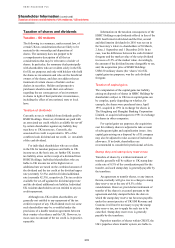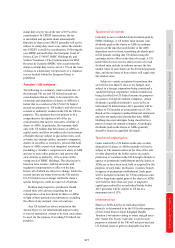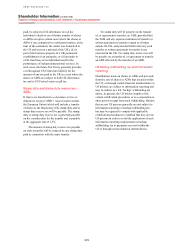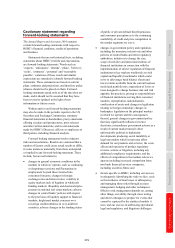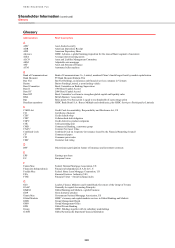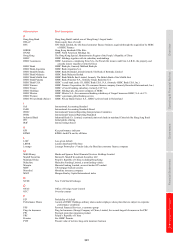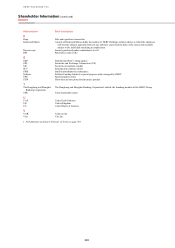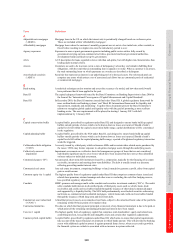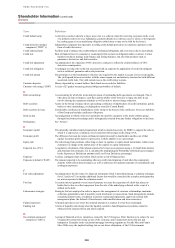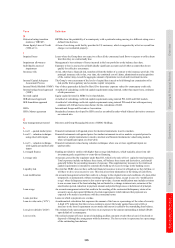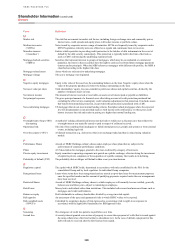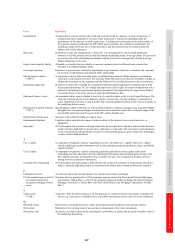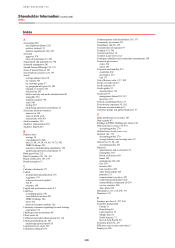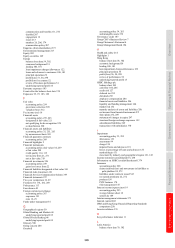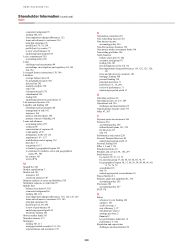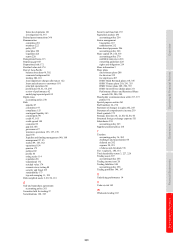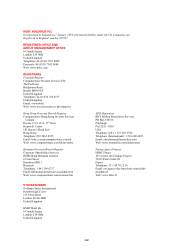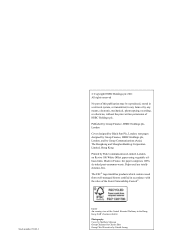HSBC 2010 Annual Report Download - page 388
Download and view the complete annual report
Please find page 388 of the 2010 HSBC annual report below. You can navigate through the pages in the report by either clicking on the pages listed below, or by using the keyword search tool below to find specific information within the annual report.
HSBC HOLDINGS PLC
Shareholder Information (continued)
Glossary
386
Term Definition
M
Market risk The risk that movements in market risk factors, including foreign exchange rates and commodity prices,
interest rates, credit spreads and equity prices will reduce income or portfolio values.
Medium term notes
(‘MTN’s)
Notes issued by corporates across a range of maturities. MTNs are frequently issued by corporates under
MTN Programmes whereby notes are offered on a regular and continuous basis to investors.
Monoline insurers
(‘monolines’)
Entities which specialise in providing credit protection to the holders of debt instruments in the event of
default by the debt security counterparty. This protection is typically held in the form of derivatives
such as CDS’s referencing the underlying exposures held.
Mortgage-backed securities
(‘MBS’s)
Securities that represent interests in groups of mortgages, which may be on residential or commercial
properties. Investors in these securities have the right to cash received from future mortgage payments
(interest and/or principal). When the MBS references mortgages with different risk profiles, the MBS is
classified according to the highest risk class.
Mortgage-related assets Assets which are referenced to underlying mortgages.
Mortgage vintage The year a mortgage was originated.
N
Negative equity mortgages Equity is the value of the asset less the outstanding balance on the loan. Negative equity arises when the
value of the property purchased is below the balance outstanding on the loan.
Net asset value per share Total shareholders’ equity, less non-cumulative preference shares and capital securities, divided by the
number of ordinary shares in issue.
Net interest income The amount of interest received or receivable on assets net of interest paid or payable on liabilities.
Net principal exposure The gross principal amount of a financial asset after taking account of credit protection purchased but
excluding the effect of any counterparty credit valuation adjustment to that protection. It includes assets
that benefit from monoline protection, except where this protection is purchased with a CDS.
Non-conforming mortgages US mortgages that do not meet normal lending criteria. Examples include mortgages where the expected
level of documentation is not provided (such as with income self-certification), or where poor credit
history increases the risk and results in pricing at a higher than normal lending rate.
O
Overnight Index Swap (‘OIS’)
discounting
A method of valuing collateralised interest rate derivatives which uses a discount curve that reflects the
overnight interest rate typically earned or paid in respect of collateral received.
Operational risk The risk of loss resulting from inadequate or failed internal processes, people and systems or from external
events, including legal risk.
Over-the-counter (‘OTC’) A bilateral transaction (e.g. derivatives) that is not exchange traded and that is valued using valuation
models.
P
Performance Shares Awards of HSBC Holdings ordinary shares under employee share plans that are subject to the
achievement of corporate performance conditions.
Prime A US description for mortgages granted to the most creditworthy category of borrowers.
Private equity investments Equity securities in operating companies not quoted on a public exchange, often involving the investment
of capital in private companies or the acquisition of a public company that results in its delisting.
Probability of default (‘PD’) The probability that an obligor will default within a one-year time horizon.
R
Regulatory capital The capital which HSBC holds, determined in accordance with rules established by the FSA for the
consolidated Group and by local regulators for individual Group companies.
Renegotiated loans Loans whose terms have been renegotiated and are treated as up-to-date loans for measurement purposes
once the specified number and/or amount of qualifying payments required under the new arrangements
have been received.
Restricted Shares Awards of HSBC Holdings ordinary shares to which employees will normally become entitled, generally
between one and three years, subject to remaining an employee.
Retail loans Money lent to individuals rather than institutions. This includes both secured and unsecured loans such as
mortgages and credit card balances.
Return on equity Profit attributable to ordinary shareholders divided by average invested capital.
Risk appetite An assessment of the types and quantum of risks to which HSBC wishes to be exposed.
Risk-weighted assets
(‘RWA’s)
Calculated by assigning a degree of risk expressed as a percentage (risk weight) to an exposure in
accordance with the applicable Standardised or IRB approach rules.
S
Seasoning The emergence of credit loss patterns in portfolios over time.
Second lien A security interest granted over an item of property to secure the repayment of a debt that is issued against
the same collateral as a first lien but that is subordinate to it. In the case of default, repayment for this
debt will only be received after the first lien has been repaid.


